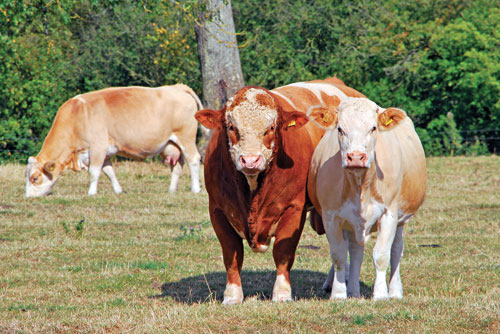Cattle producers know the importance of keeping feed for their cattle, but overweight females can cause reproductive issues, but too little feed can result in a thin, under performing cow.
Producers should strive to have their females in the optimum range for production, which for beef cattle, falls into the 5 to 6 range on the Body Conditioning Scoring System. This system goes from 1 to 9, with 1 being very thin and 9 being obese.
It is especially important for heifers to fall into this range just prior to breeding season since it is their first experience with the breeding cycle. Giving heifers the proper nutritional balance will give them the proper nutrition to set them up for success.
Traditionally, most heifers have about 160 days between when they are weaned and when they are bred for the first time to grow into and maintain a good body score. During those 160 days, producers need to thoughtfully manage heifers to prepare them for breeding, pregnancy and calving. According to Storey’s Guide to Raising Beef Cattle by Heather Smith Thomas, if a heifer weighs 500 to 600 pounds at weaning, with the genetic potential to weigh 750 to 800 pounds at breeding age (15 months), she should gain 200 to 300 pounds in the 160 days between weaning and breeding. She should be able to reach this goal on good hay alone, gaining 1.2 to 1.8 pounds per day or more.
Some producers choose to supplement heifers with additional feedstuffs. Before jumping into this more expensive option, it’s best to do a little research to determine what soon-to-be-bred heifers are actually getting from their current feed and what, if anything, is needed in the way of a supplement.
University of Missouri Extension Livestock Specialist Eldon Cole said a forage test should be done before adding any feeds or supplements.
Once it is determined what level of protein and nutrients heifers are dealing with, then producers can move on to selecting a supplement that will provide extra groceries if necessary.
“A supplement may be high-quality pasture such as wheat, rye or ryegrass, alfalfa hay, by-product feeds such as corn gluten feed, soybean hulls, dried distillers grain, corn or any number of commercially prepared meals, cubes, blocks, barrels, tubs, liquid feeds and the list goes on,” Cole said.
If heifers are heading into breeding season underfed, proceed with caution. Heifers that are smaller in size than their well-fed counterparts due to poor feeding may have problems carrying the calf to full term or experience calving issues.
With a proper feeding plan in place, you can avoid costly problems like these and help your first-calf heifers have a smooth first season.






